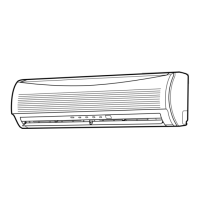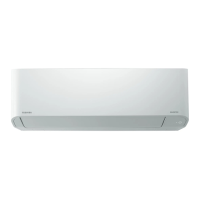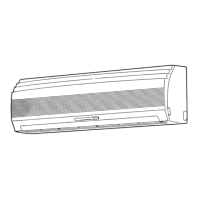– 49 –
9-2-6. Indoor Unit Installation
1. Pass the pipe through the hole in the wall, and hook
the indoor unit on the installation plate at the upper
hooks.
2. Swing the indoor unit to right and left to confirm that
it is firmly hooked up on the installation plate.
3. While pressing the indoor unit onto the wall, hook it
at the lower part on the installation plate. Pull the
indoor unit toward you to confirm that it is firmly
hooked up on the installation plate.
9-3. Outdoor Unit
9-3-1. Installation Place
• A place which provides the spaces around the outdoor
unit as shown in the left diagram.
• A place which can bear the weight of the outdoor unit and
does not allow an increase in noise level and vibration.
• A place where the operation noise and discharged air
do not disturb users neighbors.
• A place which is not exposed to a strong wind.
• A place free of a leakage of combustible gases.
• A place which does not block a passage.
• When the outdoor unit is to be installed in an elevated
position,be sure to secure its feet.
• This air cinditioner accepts a connection piping length
of up to 25 m.
• There is no need to add refrigerant as long as the
length of the connection piping is 15 m or less.
• You will need to add 20g of refrigerant per meter of
added connnection piping for installations requiring
connection piping to be between 16 m to 25 m.
• An allowable height level is up to 10 m.
• A place where the drain water does not raise any
problem.
Precautions for adding refrigerant
• Use a scale having a precision with at least 10 g per
index line when adding the refrigerant. Do not use a
bathroom scale or similar instrument.
• Use liquid refrigerant when refilling the refrigerant.
Since the refrigerant is in liquid form, it can fill quickly.
Therefore, perform the filling operation carefully and
insert the refrigerant gradually.
CAUTION
1. Install the outdoor unit without anything blocking
the air discharging.
2. When the outdoor unit is installed in a place
exposed always to a strong wind like a coast or on
a high storey of a building,secure the normal fan
operation using a duct or a wind shield.
3. Specially in windy areas, install the unit prevent
the admission of wind.
4. Installation in the following places may result in
trouble. Do not install the unit in such places.
• A place full of machine oil.
• A saline-place such as the coast.
• A place full of sulfide gas.
• A place where high-frequency
waves are likely to be generated
as from audio equipment,
welders, and medical
equipment.
Fig. 9-2-17
• For detaching the indoor unit from the installation
plate, pull the indoor unit toward you while pushing
its bottom up at the specified parts.
Fig. 9-2-18
8-2-7. Drainage
1. Run the drain hose sloped downwards.
NOTE :
• Hole should be made at a slight downward slant on
the outdoor side.
Fig. 9-2-19
2. Put water in the drain pan and make sure that the
water is being drained outside.
3. When connecting extension drain hose, insulate the
connecting part of extension drain hose with shield
pipe.
Fig. 9-2-20
CAUTION
Install the drain pipe for proper drainage.
Improper drainage can result in water dripping
inside the room.
This air conditioner has been
designed to drain water
collected from condensation
which forms on the back of the
indoor unit, to the drain pan.
Therefore, do not locate the
power cord and other parts at a
height above the drain guide.
Fig. 9-2-21
Push (unhook)
1
Installation
plate
Hook here
2
Hook
1
PushPush
50 mm
or more
Do not rise the drain hose.
Do not form the drain hose
into the waved shape.
Do not put the
drain hose end
into water.
Do not put the drain
hose end in the
drainage ditch.
Shield pipe
Extension drain hose
Inside the room
Drain hose
Space for
pipes
Wall
Drain
guide
Fig. 9-3-1
9-3-2. Refrigerant Piping Connection
Flaring
1. Cut the pipe with a pipe cutter.
Strong
wind
90˚
Obliquity Roughness Warp
Fig. 9-3-2

